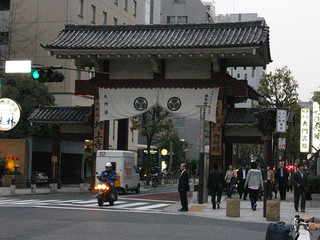Difference between revisions of "Zojo-ji"
| Line 5: | Line 5: | ||
Zôjô-ji is a [[Jodo-shu|Jôdo-shû]] Buddhist temple located in the Shiba neighborhood of [[Tokyo]]; along with [[Kan'ei-ji]], it was one of two [[Tokugawa clan]] family temples in the Tokugawa shogunal capital of [[Edo]]. Six [[Tokugawa shogunate|Tokugawa shoguns]] are buried on the temple grounds; the graves of five more can be found at Kan'ei-ji. | Zôjô-ji is a [[Jodo-shu|Jôdo-shû]] Buddhist temple located in the Shiba neighborhood of [[Tokyo]]; along with [[Kan'ei-ji]], it was one of two [[Tokugawa clan]] family temples in the Tokugawa shogunal capital of [[Edo]]. Six [[Tokugawa shogunate|Tokugawa shoguns]] are buried on the temple grounds; the graves of five more can be found at Kan'ei-ji. | ||
| − | Zôjô-ji was made a family mortuary temple of the Tokugawa clan in [[1598]]. [[Tokugawa Ieyasu]], already planning out his (future) capital, thought the location ideal for a variety of reasons, including | + | Zôjô-ji was made a family mortuary temple of the Tokugawa clan in [[1598]]. [[Tokugawa Ieyasu]], already planning out his (future) capital, thought the location ideal for a variety of reasons, including its position to the south of [[Edo castle]], protecting the city spiritually from that direction, and providing a certain symmetry to [[Nikko Toshogu|Nikkô]] in the north. An additional worship hall was completed in [[1605]], and the entire complex was renovated or refurbished in [[1634]]. |
The shogunal graves at Zôjô-ji were relocated somewhat, within the grounds, in 1958; in the process, much was learned about shogunal funerary practices. Though the graves were off-limits to the public for many years, beginning in 2008, the shogunal cemetery has been opened to the public on set days of the year. | The shogunal graves at Zôjô-ji were relocated somewhat, within the grounds, in 1958; in the process, much was learned about shogunal funerary practices. Though the graves were off-limits to the public for many years, beginning in 2008, the shogunal cemetery has been opened to the public on set days of the year. | ||
| + | |||
| + | ==Shogunal graves== | ||
| + | The grave of Shogun [[Tokugawa Ienobu]] is among the best preserved, and provides an indication of how most of the shoguns were likely buried. His body, dressed in the formal court robes of a ''[[naidaijin]]'' and with his hair in a topknot, was embalmed and laid to rest in two wooden coffins, which were in turn placed within a copper coffin, within a stone chamber. A mace was left in his hands, and a sword at his side. Ash and lime were packed into the chamber, and into the coffins. | ||
{{stub}} | {{stub}} | ||
Revision as of 16:48, 13 September 2013
- Japanese: 増上寺 (zoujou-ji)
Zôjô-ji is a Jôdo-shû Buddhist temple located in the Shiba neighborhood of Tokyo; along with Kan'ei-ji, it was one of two Tokugawa clan family temples in the Tokugawa shogunal capital of Edo. Six Tokugawa shoguns are buried on the temple grounds; the graves of five more can be found at Kan'ei-ji.
Zôjô-ji was made a family mortuary temple of the Tokugawa clan in 1598. Tokugawa Ieyasu, already planning out his (future) capital, thought the location ideal for a variety of reasons, including its position to the south of Edo castle, protecting the city spiritually from that direction, and providing a certain symmetry to Nikkô in the north. An additional worship hall was completed in 1605, and the entire complex was renovated or refurbished in 1634.
The shogunal graves at Zôjô-ji were relocated somewhat, within the grounds, in 1958; in the process, much was learned about shogunal funerary practices. Though the graves were off-limits to the public for many years, beginning in 2008, the shogunal cemetery has been opened to the public on set days of the year.
Shogunal graves
The grave of Shogun Tokugawa Ienobu is among the best preserved, and provides an indication of how most of the shoguns were likely buried. His body, dressed in the formal court robes of a naidaijin and with his hair in a topknot, was embalmed and laid to rest in two wooden coffins, which were in turn placed within a copper coffin, within a stone chamber. A mace was left in his hands, and a sword at his side. Ash and lime were packed into the chamber, and into the coffins.
References
- Anne Walthall, "Hiding the shoguns: Secrecy and the nature of political authority in Tokugawa Japan," in Bernard Scheid and Mark Teeuwen (eds.) The Culture of Secrecy in Japanese Religion, Routledge (2006), 331-356.

